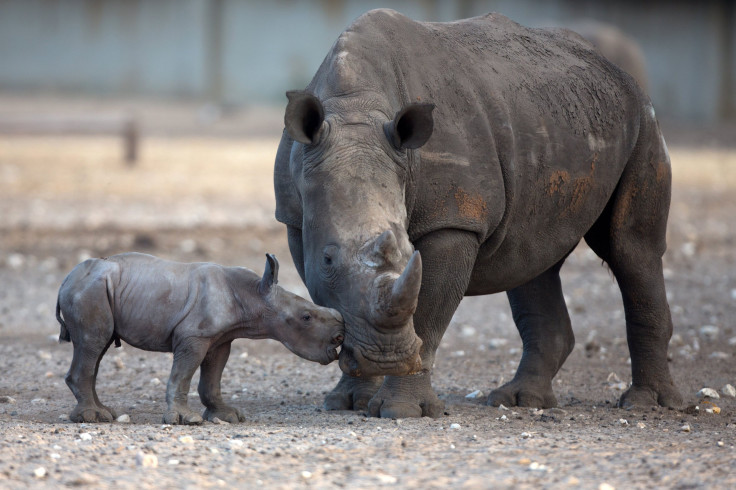World Rhino Day 2015: 10 Facts, Photos About Rhinoceros To Spread Awareness About Endangered Species

Tuesday marked World Rhino Day and wildlife conservationists and concerned individuals alike are celebrating the large, horned herbivores by spreading awareness about the vulnerable species. Started by conservation group WWF South Africa in 2010, World Rhino Day has grown into a global phenomenon to spread the word about both the beauty of rhinoceros and the dangers they are facing. Here are ten stunning photos and interesting facts about rhinos, as well as ways to contribute to World Rhino Day.
1. There are five species of rhino, which are indigenous to Africa and Asia: black, white, greater one-horned or Indian, Sumatran and Javan rhinos. World Rhino Day celebrates all five species.
2. Rhinos have been around for more than 50 million years. Some of the world’s first rhinos didn’t have horns and roamed through North America and Europe. But no known rhino species have ever inhabited the South American or Australian continents. The Sumatran rhino is the closest living relative of the ancient woolly rhino.
Meet Bali the greater one-horned rhino, a new arrival at Whipsnade Zoo #WorldRhinoDay Picture: ZSL/PA Wire pic.twitter.com/O01h8IewZF
— Press Association (@PA) September 22, 20153. Rhino is short for rhinocerous, which means “nose horn.” The rhino’s horn is not bone and it’s not attached to its skull. In fact, its hollow and made from a protein called keratin, the same substance that makes up fingernails and hair. Just like our own hair and nails, a rhino’s horn continues to grow throughout the animal’s lifetime. The longest known horn was 4 feet 9 inches long on a black rhino, which on average has a 20-inch horn, according to Save the Rhino, a conservation charity based in the United Kingdom.
4. Three of the rhino species are listed as “critically endangered” by the International Union for the Conservation of Nature (IUCN) Red List of Threatened Species, which means they have a 50 percent chance of becoming extinct in three generations. With its headquarters in the United Kingdom, the IUCN is the world’s leading authority on the conservation status of species.
5. The IUCN Red List identifies Javan and Sumatran rhinos, two species native to Asia, and the black rhino, which is native to eastern and central Africa, as “critically endangered.” The Indian or greater one-horned rhino, native to the Indian subcontinent, is identified as “vulnerable.” And the white rhino, which mainly lives in South Africa, is identified as “near threatened.”
A rhino was slaughtered every 8 hours in 2014 -- and this year could be worse: http://t.co/XrhBDO4nhj #WorldRhinoDay pic.twitter.com/8TuOVHootk
— CNN (@CNN) September 22, 20156. Rhinos can grow to over 6 feet tall and more than 11 feet long. The white rhino is the second largest land mammal after the elephant, with adult males weighing up to a massive 3.6 tons. Thanks to conservation efforts, this rhino species was brought back from the brink of extinction. But a surge in poaching for their horns has seen a record number killed in recent years. There are 20,000 southern white rhinos living in protected areas and private game reserves, mostly in South Africa, and just four northern white rhinos living in captivity in Kenya and the United States, according to WWF.
7. The Javan rhino is the world’s rarest land mammal and less than 50 survive in Indonesia’s Ujong Kulon National Park, according to Save the Rhino.
8. Rhinos have poor eyesight and have difficulty detecting someone only a hundred feet away. But they have a high sense of smell and well-developed hearing and can run up to 40 miles per hour.
9. Rhinos have thick skin that can be very sensitive to sunburns and insect bites. The animals wallow in mud, which protects their skin from the sun and bites when it dries.
It’s #WorldRhinoDay! Let's celebrate these amazing species and protect them for future generations. #iam4rhinos pic.twitter.com/pV7NoxaVRG
— WWF South Africa (@WWFSouthAfrica) September 22, 201510. Rhinoceros pregnancies last for 15 to 16 months and mother rhinos are very nurturing. Their young stay with them until they are about 3 years old, according to Save the Rhino.
To celebrate World Rhino Day, visit Haus and Toy, two white rhinos at Canada’s Safari Niagara in Stevensville, Ontario. Be sure to post photos of Haus and Toy on social media using the hashtags #safariniagara and #worldrhinoday to spread love and awareness about the endangered species on social media.
© Copyright IBTimes 2024. All rights reserved.





















